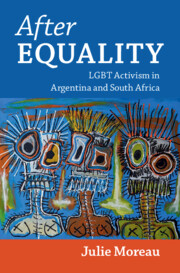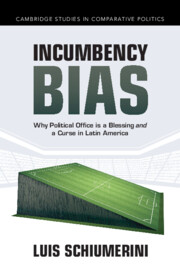Refine search
Actions for selected content:
437 results
New insights into the graptolite biostratigraphy of the Floian (Lower Ordovician) Acoite Formation at El Moreno, Cordillera Oriental of Argentina
-
- Journal:
- Geological Magazine / Volume 162 / 2025
- Published online by Cambridge University Press:
- 17 September 2025, e36
-
- Article
-
- You have access
- Open access
- HTML
- Export citation
Chapter 4 - Women Take Up Arms
-
-
- Book:
- Antifascism(s) in Latin America and the Caribbean
- Published online:
- 21 July 2025
- Print publication:
- 07 August 2025, pp 90-106
-
- Chapter
- Export citation
6 - The Roots of Weak Democracies
-
- Book:
- The Birth of Democracy in South America
- Published online:
- 04 June 2025
- Print publication:
- 07 August 2025, pp 175-223
-
- Chapter
-
- You have access
- Open access
- HTML
- Export citation
Chapter 7 - Local Contexts and Transnational Influences
-
-
- Book:
- Antifascism(s) in Latin America and the Caribbean
- Published online:
- 21 July 2025
- Print publication:
- 07 August 2025, pp 143-163
-
- Chapter
- Export citation
Cyclical implications of the balance-of-payments constraint in Argentina (1930–2018): Implicaciones cíclicas de la restricción de balanza de pagos en Argentina (1930–2018)
-
- Journal:
- Revista de Historia Economica - Journal of Iberian and Latin American Economic History , First View
- Published online by Cambridge University Press:
- 21 July 2025, pp. 1-42
-
- Article
-
- You have access
- Open access
- HTML
- Export citation
Democratisation and the Adoption of Compulsory Voting
-
- Journal:
- Journal of Latin American Studies , First View
- Published online by Cambridge University Press:
- 14 July 2025, pp. 1-25
-
- Article
- Export citation
Morphological data and molecular characterization of Lagostonema ecasiense (Nematoda, Molineidae) parasite of Lagostomus maximus (Rodentia, Chinchillidae) from Argentina and other considerations
-
- Journal:
- Parasitology , First View
- Published online by Cambridge University Press:
- 14 July 2025, pp. 1-14
-
- Article
-
- You have access
- Open access
- HTML
- Export citation
The agency of women in the common kitchen programme in Tucumán (Argentina)
- Part of
-
- Journal:
- The Economic and Labour Relations Review ,
- Published online by Cambridge University Press:
- 10 July 2025, pp. 1-14
-
- Article
- Export citation
The Other Hand of God: The Impact of the 1988–1989 Drought in Argentina
-
- Journal:
- Latin American Research Review ,
- Published online by Cambridge University Press:
- 01 July 2025, pp. 1-16
-
- Article
-
- You have access
- Open access
- HTML
- Export citation

After Equality
- LGBT Activism in Argentina and South Africa
-
- Published online:
- 19 June 2025
- Print publication:
- 03 July 2025
7 - Microfoundations of Incumbency Bias
-
- Book:
- Incumbency Bias
- Published online:
- 17 May 2025
- Print publication:
- 05 June 2025, pp 164-190
-
- Chapter
- Export citation
5 - When Capacity Meets Authority
-
- Book:
- Incumbency Bias
- Published online:
- 17 May 2025
- Print publication:
- 05 June 2025, pp 111-140
-
- Chapter
- Export citation
3 - Latin American Social Medicine, across the Waves
-
-
- Book:
- Medicine on a Larger Scale
- Published online:
- 05 May 2025
- Print publication:
- 22 May 2025, pp 60-80
-
- Chapter
-
- You have access
- Open access
- HTML
- Export citation

Incumbency Bias
- Why Political Office is a Blessing and a Curse in Latin America
-
- Published online:
- 17 May 2025
- Print publication:
- 05 June 2025
The Opposite of Containment: Electoral System Change in Argentina’s 1912 Democratic Transition
-
- Journal:
- Latin American Politics and Society / Volume 67 / Issue 3 / August 2025
- Published online by Cambridge University Press:
- 09 May 2025, pp. 26-44
-
- Article
-
- You have access
- Open access
- HTML
- Export citation
Activating without Transforming: The Use of Technology to Engage Activists in Political Campaigns
-
- Journal:
- Latin American Politics and Society / Volume 67 / Issue 3 / August 2025
- Published online by Cambridge University Press:
- 05 May 2025, pp. 69-84
-
- Article
-
- You have access
- HTML
- Export citation
5 - Fraud on the River
- from Part II - Putting Victims at the Center of Anti-Corruption Work
-
- Book:
- Fighting Grand Corruption
- Published online:
- 03 April 2025
- Print publication:
- 10 April 2025, pp 77-103
-
- Chapter
- Export citation
Chapter 5 - Manipulating Statistics and Statisticians
-
- Book:
- Politicians Manipulating Statistics
- Published online:
- 31 May 2025
- Print publication:
- 03 April 2025, pp 91-121
-
- Chapter
- Export citation
Ignoring Women’s Performance: A Survey Experiment on Policy Implementation in Argentina
-
- Journal:
- British Journal of Political Science / Volume 55 / 2025
- Published online by Cambridge University Press:
- 02 April 2025, e54
-
- Article
-
- You have access
- Open access
- HTML
- Export citation
New northernmost record of Clathria (Clathria) unica and updated records of Cliona aff. celata and Spongia (Spongia) magellanica in Mar del Plata, Argentina, SW Atlantic Ocean
-
- Journal:
- Journal of the Marine Biological Association of the United Kingdom / Volume 105 / 2025
- Published online by Cambridge University Press:
- 25 February 2025, e28
-
- Article
- Export citation
